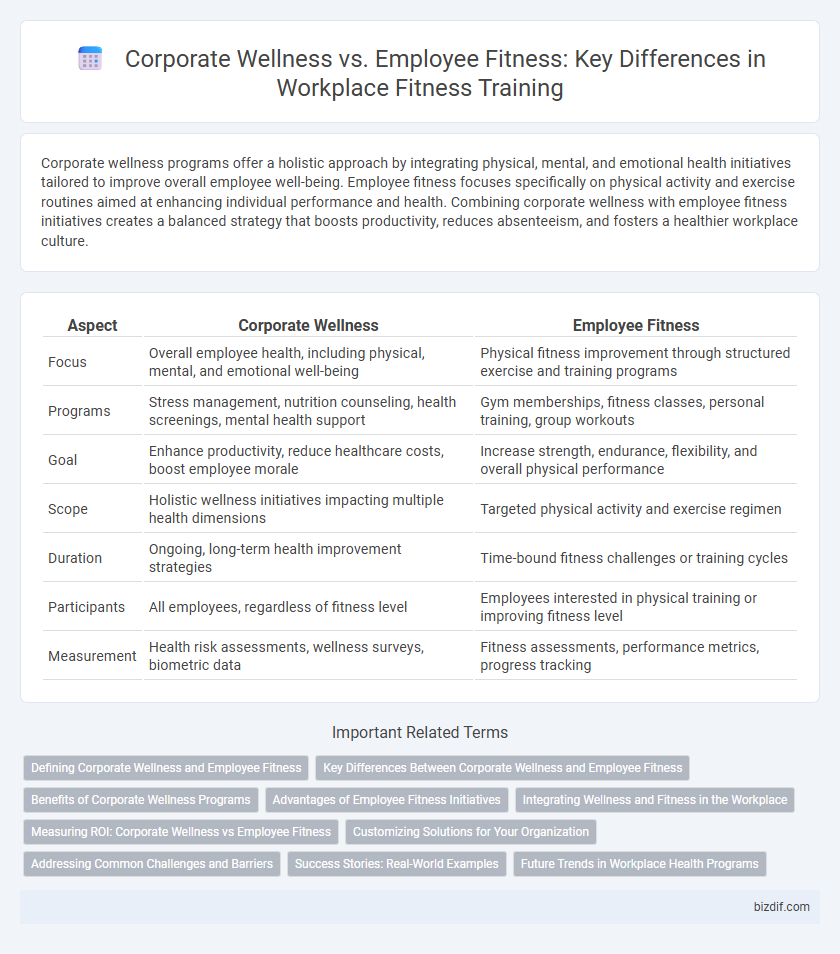Corporate wellness programs offer a holistic approach by integrating physical, mental, and emotional health initiatives tailored to improve overall employee well-being. Employee fitness focuses specifically on physical activity and exercise routines aimed at enhancing individual performance and health. Combining corporate wellness with employee fitness initiatives creates a balanced strategy that boosts productivity, reduces absenteeism, and fosters a healthier workplace culture.
Table of Comparison
| Aspect | Corporate Wellness | Employee Fitness |
|---|---|---|
| Focus | Overall employee health, including physical, mental, and emotional well-being | Physical fitness improvement through structured exercise and training programs |
| Programs | Stress management, nutrition counseling, health screenings, mental health support | Gym memberships, fitness classes, personal training, group workouts |
| Goal | Enhance productivity, reduce healthcare costs, boost employee morale | Increase strength, endurance, flexibility, and overall physical performance |
| Scope | Holistic wellness initiatives impacting multiple health dimensions | Targeted physical activity and exercise regimen |
| Duration | Ongoing, long-term health improvement strategies | Time-bound fitness challenges or training cycles |
| Participants | All employees, regardless of fitness level | Employees interested in physical training or improving fitness level |
| Measurement | Health risk assessments, wellness surveys, biometric data | Fitness assessments, performance metrics, progress tracking |
Defining Corporate Wellness and Employee Fitness
Corporate wellness encompasses comprehensive programs designed to improve overall employee health, including mental, physical, and emotional well-being, fostering a productive workplace culture. Employee fitness specifically targets physical activity initiatives, such as exercise routines and fitness challenges, aimed at enhancing individual health and reducing absenteeism. Both strategies contribute to organizational success by promoting healthier, more engaged employees and reducing healthcare costs.
Key Differences Between Corporate Wellness and Employee Fitness
Corporate wellness programs encompass holistic strategies targeting physical, mental, and emotional health across the entire organization, integrating initiatives like stress management, nutrition counseling, and health risk assessments. Employee fitness focuses specifically on improving physical activity and exercise routines for individual workers through gym memberships, fitness classes, or personalized workout plans. The key difference lies in corporate wellness's comprehensive approach addressing overall well-being, while employee fitness targets physical fitness as a component of health.
Benefits of Corporate Wellness Programs
Corporate wellness programs enhance employee productivity by reducing stress and promoting healthier lifestyle choices, which lowers absenteeism and healthcare costs. These programs foster a positive work culture through group fitness activities, nutrition workshops, and mental health support sessions, directly increasing employee engagement and job satisfaction. Employers experience improved workforce morale and decreased turnover rates, making corporate wellness a strategic investment in long-term organizational success.
Advantages of Employee Fitness Initiatives
Employee fitness initiatives improve overall workforce productivity by reducing absenteeism and enhancing energy levels throughout the workday. These programs promote physical health, which decreases healthcare costs and lowers the risk of chronic diseases among employees. Engaging employees in regular fitness activities fosters team cohesion and boosts morale, leading to a more motivated and efficient workforce.
Integrating Wellness and Fitness in the Workplace
Integrating wellness and fitness in the workplace enhances employee productivity by promoting physical health and reducing stress. Corporate wellness programs that include fitness activities, mental health support, and nutrition education foster a holistic approach to employee well-being. Companies investing in comprehensive wellness initiatives see lower absenteeism, improved morale, and higher retention rates.
Measuring ROI: Corporate Wellness vs Employee Fitness
Measuring ROI in corporate wellness programs involves analyzing improvements in employee productivity, reduced healthcare costs, and decreased absenteeism, directly impacting overall organizational performance. Employee fitness initiatives provide tangible data through biometric screenings, fitness assessments, and activity tracking, allowing precise evaluation of physical health benefits and engagement levels. Comparing these metrics helps businesses allocate resources effectively by balancing holistic wellness strategies with targeted fitness interventions.
Customizing Solutions for Your Organization
Customizing solutions for corporate wellness and employee fitness involves tailoring programs to meet the unique needs of your organization's workforce. Incorporating data-driven assessments, personalized workout plans, and flexible scheduling enhances participation and improves overall employee health. Leveraging technology such as fitness apps and wearable devices enables real-time tracking and continuous engagement, optimizing wellness outcomes.
Addressing Common Challenges and Barriers
Corporate wellness programs target holistic health improvements by integrating mental, physical, and nutritional support, effectively reducing absenteeism and boosting productivity. Employee fitness initiatives directly tackle barriers such as lack of time, motivation, and access to facilities with tailored workout plans and flexible scheduling. Combining both approaches maximizes engagement by addressing diverse challenges, fostering a healthier workforce and reducing healthcare costs.
Success Stories: Real-World Examples
Corporate wellness programs have boosted productivity and reduced healthcare costs at companies like Johnson & Johnson, which reported a 28% reduction in sick leave after implementing comprehensive wellness initiatives. Employee fitness challenges at Google led to a 20% increase in employee engagement and a measurable improvement in cardiovascular health among participants. These real-world examples highlight how targeted fitness and wellness strategies drive measurable business and health outcomes.
Future Trends in Workplace Health Programs
Corporate wellness programs are evolving with an increased emphasis on personalized employee fitness plans driven by AI and wearable technology. Future workplace health initiatives will integrate mental health support and virtual fitness platforms to enhance overall employee well-being. Data analytics will play a crucial role in customizing fitness interventions and measuring program effectiveness to boost productivity and reduce healthcare costs.
Corporate Wellness vs Employee Fitness Infographic

 bizdif.com
bizdif.com